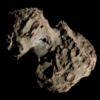astro.wikisort.org - Comet
157P/Tritton is a periodic comet with a 6 year orbital period. Fragment B was first observed on 21 August 2021.[3]
| Discovery | |
|---|---|
| Discovered by | Keith Tritton |
| Discovery date | February 11, 1978 |
| Alternative designations | 1977 XIII |
| Orbital characteristics A | |
| Epoch | March 6, 2006 |
| Aphelion | 5.503 AU |
| Perihelion | 1.415 AU |
| Semi-major axis | 3.459 AU |
| Eccentricity | 0.5909 |
| Orbital period | 6.433 a |
| Inclination | 7.1263° |
| Last perihelion | June 10, 2016[1] February 20, 2010 |
| Next perihelion | 2022-Sep-09[2] |
Discovery
Keith Tritton (U. K. Schmidt Telescope Unit, Coonabarabran) discovered this comet on a deep IIIa-J exposure made with the 122-cm Schmidt telescope on 1978 February 11.66.[4]
Historical Highlights
- A preliminary orbit was calculated by M. P. Candy (Perth Observatory, Australia) using positions obtained by Tritton on February 11, 13, and 15. It was an elliptical orbit with a perihelion date of 1977 October 30.07 and an orbital period of 7.30 years. B. G. Marsden (Smithsonian Astrophysical Observatory) revised the orbit using five positions spanning the period of February 11 to March 13. He also gave an elliptical orbit with a perihelion date of October 28.51 and an orbital period of 6.33 years.
- Moonlight made observations impossible during the last half of February 1978 and during the early days of March; however, the comet was found by J. H. Bulger (Harvard Observatory's Agassiz Station) on March 10.27. He gave the nuclear magnitude as 20. The last three observations of the comet were obtained by Shao on March 11.28, 13.20, and 14.21. On IAU Circular No. 3194, issued on 1978 March 15, Marsden wrote, "It is possible that the comet experienced an outburst around the time of the Harvard observation on Feb. 15...." No observations were obtained thereafter.
- The comet was not detected during the predicted returns of 1984, 1990 or 1996 and was presumed lost.
- However, on 2003 October 6.44, using CCD images obtained with a 0.12-m refractor, C. W. Juels (Fountain Hills, Arizona, USA) and P. Holvorcem (Campinas, Brazil) detected a comet that proved to be on a similar orbit to the lost comet. B. G. Marsden was able to calculate a new orbit, published in IAU Circular No. 8215, issued 2003 October 7, which confirmed that it was indeed identical to comet Tritton.[4]
- The comet was also recovered at its 2010, 2016, and 2022 apparitions.
- On 2 October 2022 the discovery of a new fragment of the comet was published in MPEC 2022-T23.[3]
References
- Syuichi Nakano (2012-03-24). "157P/Tritton (NK 1900)". OAA Computing and Minor Planet Sections. Retrieved 2012-02-25.
- "157P/Tritton Orbit". Minor Planet Center. Retrieved 2017-04-09.
- "MPEC 2022-T23 : New Fragment of comet 157P/TRITTON". IAU Minor Planet Center. 2022-10-02. Retrieved 2022-10-19.
- "157P/Tritton". Archived from the original on 2006-03-16. Retrieved 2006-02-22.
External links
- Orbital simulation from JPL (Java) / Horizons Ephemeris
- 157P/Tritton – Seiichi Yoshida @ aerith.net
- 157P at Gary W. Kronk's Cometography
На других языках
- [en] 157P/Tritton
[ru] 157P/Триттона
Комета Триттона (157P/Tritton) — короткопериодическая комета из семейства Юпитера, которая была обнаружена 11 февраля 1978 года американским астрономом Китом Триттоном с помощью 1,2-метрового телескопа Шмидта обсерватории Сайдинг-Спринг. Комета выглядела как диффузный объект 20,0 m звёздной величины, со слабо различимым ядром в центре и небольшим хвостом. Комета обладает довольно коротким периодом обращения вокруг Солнца — чуть более 6,3 года.Текст в блоке "Читать" взят с сайта "Википедия" и доступен по лицензии Creative Commons Attribution-ShareAlike; в отдельных случаях могут действовать дополнительные условия.
Другой контент может иметь иную лицензию. Перед использованием материалов сайта WikiSort.org внимательно изучите правила лицензирования конкретных элементов наполнения сайта.
Другой контент может иметь иную лицензию. Перед использованием материалов сайта WikiSort.org внимательно изучите правила лицензирования конкретных элементов наполнения сайта.
2019-2025
WikiSort.org - проект по пересортировке и дополнению контента Википедии
WikiSort.org - проект по пересортировке и дополнению контента Википедии

